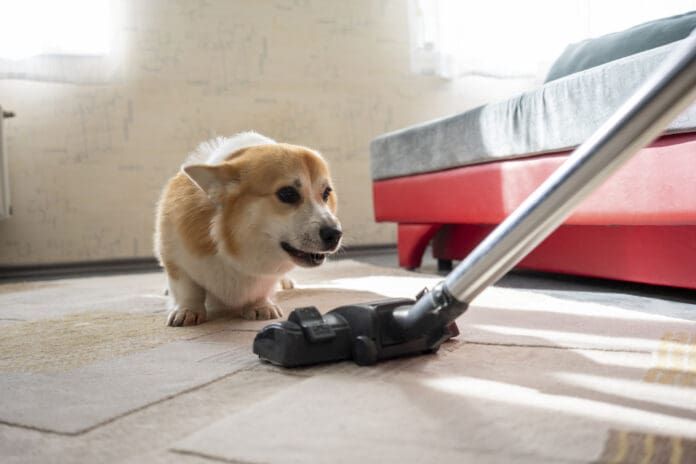It’s no secret that dogs as a species have better hearing than humans. Exactly how much better is still a matter of scientific investigation, but studies have shown that dogs’ hearing is both more sensitive and has more range, particularly at the higher-frequency end of the scale, than our own. This can create complications when things that sound fine—or are even inaudible—to us come across as painfully loud or jarring to our canine companions.
While every individual is different, there are some noises that are more likely to make dogs uncomfortable or frightened. Among the most common sounds dogs hate are:
- Vacuum Cleaners: Why do dogs hate vacuums? They are loud, often make high-pitched whistling noises, move strangely (if you’re a dog), create vibrations that can be felt through the floor, and smell weird.
- Thunderstorms: Thunderstorms can be particularly hard on sound-sensitive dogs. The sound of thunder is just one piece of it—barometric pressure changes, flashing lightning, wind, and rain noise may also be part of what your dog is afraid of.
- Fireworks/Gunshots: Loud, explosive noises that seemingly come out of nowhere—often accompanied by flashes of light and strong smells—can be terrifying to dogs.
- Alarms/Sirens: From smoke alarms in the kitchen to fire trucks on the street, high-pitched, repetitive alarms and sirens can trigger negative reactions.
The noises listed above are just some of the standard culprits when it comes to sounds dogs hate. Lawnmowers, hairdryers, power tools, crying babies, big trucks or buses passing on the street, and car horns also regularly make the list.
When Sounds Dogs Hate Become a Problem
Dog and human alike, most of us have some kind of startle reaction to sudden, loud noises. If your dog jumps when you accidentally drop a metal cooking pot on the hard kitchen floor, that’s totally normal. Chances are, I would too. If she quickly returns to whatever she was doing and doesn’t show any signs of being further bothered by the experience, you probably don’t need to do anything other than to try not to drop too many things around her.
However, if you drop a pot and your dog runs and hides for an extended period of time, refuses to return to the kitchen on her own, or gets anxious whenever you pick up a pot, she may need some help to get through her fear of the noise—particularly if it is something that occurs regularly in her life. This kind of sound sensitivity is, perhaps, easiest to identify in dogs who are afraid of thunderstorms. A few drops of rain or a rumble of thunder so far away a human can barely hear it may send a sound-sensitive dog into a panic as she anticipates the terrible noise to come.
Fearful reactions to sounds can range from mild upset to extreme terror. As discussed in “Is Your Dog Afraid of Noises?”, there are a number of ways to help your dog deal with sounds she is sensitive to:
- Management comes first. Figure out which sounds are upsetting your dog and find ways to remove or mitigate them. Mitigation can include taking her to a quiet, well insulated room, putting her in a covered crate if she is comfortable being crated, and a using white noise machine or music to help block out the noise.
- Behavior modification techniques such as counter-conditioning and desensitization can be used to help your dog overcome her fear of sounds. Make sure you understand exactly what you need to do before starting a desensitization/counter-conditioning program since doing it incorrectly can make fearful responses worse.
- Professional help can be invaluable when dealing with a significant fear reaction to specific sounds. Don’t be afraid to consult with a good fear-free behaviorist on desensitization techniques. A veterinarian may also have recommendations for medications to help keep your dog calm if she is fearful to the point of potentially injuring herself.
How to Desensitize a Dog to Sounds
Depending on the severity of the problem, desensitizing a dog to sounds that frighten her can be a challenging, time-consuming undertaking. As mentioned above, it is important to understand how desensitization and counter-conditioning function before getting started to avoid scaring the dog further. If you are at all uncertain about how to proceed, it is extremely important to talk to a professional first.
Desensitization works by gradually exposing the dog to the fear-causing noise by starting at a very low intensity and increasing it slowly as the dog gets comfortable with the sound. For a dog afraid of thunderstorms or fireworks, this usually means beginning with a recording of the noise played almost inaudibly and, over time, raising the volume little bit by little bit. Properly done, the sound should never reach a level that triggers a full fear response.
Desensitization usually goes hand-in-hand with counter-conditioning, which seeks to replace fear of the sound with positive associations. This needs to be done as a deliberate part of the desensitization program with good things—such as favorite toys, cuddles, games, and treats—coming when the dog is relatively calm in the presence of the problem sounds.
For an in-depth, step-by-step discussion of counter-conditioning and how to desensitize a dog to sounds see “Dogs With An Unhealthy Fear of Storms and Loud Noises.”






